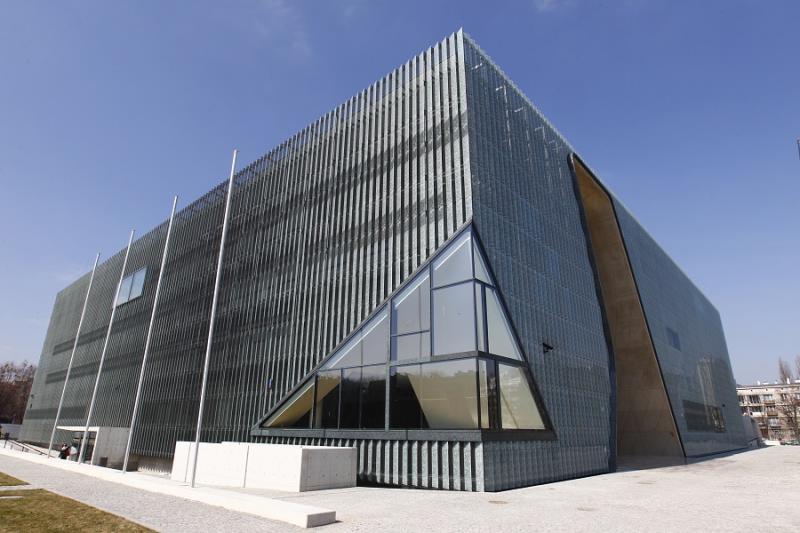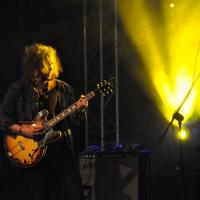theartsdesk in Warsaw: A New Jewish Museum | reviews, news & interviews
theartsdesk in Warsaw: A New Jewish Museum
theartsdesk in Warsaw: A New Jewish Museum
Although only 7,500 Jews live in Poland, a space dedicated to their history has opened in the old Ghetto

The Ghetto Heroes Square in the Muranow district of Warsaw is a bleak place surrounded by drab apartment blocks. But at its centre there’s now a new building that attracted over 15,000 visitors in the first two days of its opening on 20 and 21 April, the 70th anniversary of the Warsaw Ghetto Uprising of 1943. It’s particularly remarkable as the building doesn’t yet have any exhibits on show.
The Museum of the History of Polish Jews stands at the heart of what was the Warsaw Ghetto. At the time of the uprising, there were an estimated 60,000 inhabitants and, faced with the stark choice of fighting to the death or deportation to Treblinka, the Jewish Combat Organisation (ZOB) led by Mordechai Anieliewicz fought against overwhelming Nazi firepower for nearly a month. Very few survived. In 1939 around a third of Warsaw’s population was Jewish (some 380,000 people), whereas now, according to the 2011 census, the whole of Poland is home to just 7,500 Jews – which makes the 17,000 visitors even more remarkable.
Seventy years might seem a long time to wait for a museum dedicated to a third of the population
The new museum faces the monument to the Ghetto Heroes, with Anieliewicz at its centre, erected in 1948. Designed by Finnish architects, Rainer Mahlamäki and Ilmari Lahdelma, the building is a functional square shape, dominated by straight lines. While the building is masculine and metallic on the outside, inside it is feminine and curvy built from a sandy-coloured stone (pictured below and gallery). Our guide, Natalia Pankowska, talks of the symbolism of the bridges inside and the doorway modelled on the letter "tav" that ends the Hebrew alphabet – but there’s nothing as extensive as Libeskind’s "Stair of Continuity" or "Holocaust Void". An Israeli friend caused consternation by saying the lattice around the entrance reminded him of a swastika, adding “You can see anything you want to see.”
 The museum is not just about the Ghetto Uprising and the Holocaust, but a thousand years of Jewish history in Poland. At the moment there’s a film to show the themes of the eight galleries that are below ground level. A medieval gallery will be about the first Jews visiting and settling in Poland from the 10th century, another gallery will be about the so-called Golden Age during the Polish-Lithuanian Commonwealth with a large model of the city of Krakow and its still surviving Jewish quarter Kazimierz. A highlight will be the recreation of the colourfully painted roof of the wooden synagogue in the shtetl town of Gwoździec built in 1640. There were 180 wooden synagogues in Poland, all destroyed by the Nazis, but there are extensive pictures of the interior of this one, so experts have been able to recreate it. The later galleries cover the interwar period, the Holocaust and the postwar years.
The museum is not just about the Ghetto Uprising and the Holocaust, but a thousand years of Jewish history in Poland. At the moment there’s a film to show the themes of the eight galleries that are below ground level. A medieval gallery will be about the first Jews visiting and settling in Poland from the 10th century, another gallery will be about the so-called Golden Age during the Polish-Lithuanian Commonwealth with a large model of the city of Krakow and its still surviving Jewish quarter Kazimierz. A highlight will be the recreation of the colourfully painted roof of the wooden synagogue in the shtetl town of Gwoździec built in 1640. There were 180 wooden synagogues in Poland, all destroyed by the Nazis, but there are extensive pictures of the interior of this one, so experts have been able to recreate it. The later galleries cover the interwar period, the Holocaust and the postwar years.
Seventy years might seem a long time to wait for a museum dedicated to a third of the population who were almost wiped out so brutally. But the whole period of Soviet domination meant it was impossible accurately to assess Polish history till after 1989. The Museum of the Warsaw Uprising, which left the centre of the city entirely destroyed with some 200,000 fatalities in 1944 while the Red Army was across the river, was opened only a decade ago.
It’s impossible to know whether the museum will just present a positive image of Jewish history in Poland or how much it will go into Polish anti-Semitism and the reasons for it. But over the last 20 years, there’s been a noticeable growth of interest in Jewish history in Poland with some powerful books, films and plays examining it – notably Roman Polanski’s The Pianist and Tadeusz Słobodzianek’s Our Class, which played at the National Theatre in 2009.
“I don’t know if we can talk about a renaissance of Jewish identity and culture in Poland right now,” said out guide, “but hopefully this museum will help.” Early May has also seen the fourth edition of the New Jewish Music festival and the extraordinary Hassidic surf guitar band Alte Zachen playing in the museum for Museum Night (see gallery below) with the opening of the first exhibition of pre-war film footage from Polish Jewish shtetls. The museum is clearly keen to represent the present as well as the past.
Explore topics
Share this article
The future of Arts Journalism
You can stop theartsdesk.com closing!
We urgently need financing to survive. Our fundraising drive has thus far raised £49,000 but we need to reach £100,000 or we will be forced to close. Please contribute here: https://gofund.me/c3f6033d
And if you can forward this information to anyone who might assist, we’d be grateful.

Subscribe to theartsdesk.com
Thank you for continuing to read our work on theartsdesk.com. For unlimited access to every article in its entirety, including our archive of more than 15,000 pieces, we're asking for £5 per month or £40 per year. We feel it's a very good deal, and hope you do too.
To take a subscription now simply click here.
And if you're looking for that extra gift for a friend or family member, why not treat them to a theartsdesk.com gift subscription?
more Visual arts
 'We are bowled over!' Thank you for your messages of love and support
Much-appreciated words of commendation from readers and the cultural community
'We are bowled over!' Thank you for your messages of love and support
Much-appreciated words of commendation from readers and the cultural community
 Sir Brian Clarke (1953-2025) - a personal tribute
Remembering an artist with a gift for the transcendent
Sir Brian Clarke (1953-2025) - a personal tribute
Remembering an artist with a gift for the transcendent
 Emily Kam Kngwarray, Tate Modern review - glimpses of another world
Pictures that are an affirmation of belonging
Emily Kam Kngwarray, Tate Modern review - glimpses of another world
Pictures that are an affirmation of belonging
 Kiefer / Van Gogh, Royal Academy review - a pairing of opposites
Small scale intensity meets large scale melodrama
Kiefer / Van Gogh, Royal Academy review - a pairing of opposites
Small scale intensity meets large scale melodrama
 Jenny Saville: The Anatomy of Painting, National Portrait Gallery review - a protégé losing her way
A brilliant painter in search of a worthwhile subject
Jenny Saville: The Anatomy of Painting, National Portrait Gallery review - a protégé losing her way
A brilliant painter in search of a worthwhile subject
 Abstract Erotic, Courtauld Gallery review - sculpture that is sensuous, funny and subversive
Testing the boundaries of good taste, and winning
Abstract Erotic, Courtauld Gallery review - sculpture that is sensuous, funny and subversive
Testing the boundaries of good taste, and winning
 Edward Burra, Tate Britain review - watercolour made mainstream
Social satire with a nasty bite
Edward Burra, Tate Britain review - watercolour made mainstream
Social satire with a nasty bite
 Ithell Colquhoun, Tate Britain review - revelations of a weird and wonderful world
Emanations from the unconscious
Ithell Colquhoun, Tate Britain review - revelations of a weird and wonderful world
Emanations from the unconscious
 Rachel Jones: Gated Canyons, Dulwich Picture Gallery review - teeth with a real bite
Mouths have never looked so good
Rachel Jones: Gated Canyons, Dulwich Picture Gallery review - teeth with a real bite
Mouths have never looked so good
 Yoshitomo Nara, Hayward Gallery review - sickeningly cute kids
How to make millions out of kitsch
Yoshitomo Nara, Hayward Gallery review - sickeningly cute kids
How to make millions out of kitsch
 Hamad Butt: Apprehensions, Whitechapel Gallery review - cool, calm and potentially lethal
The YBA who didn’t have time to become a household name
Hamad Butt: Apprehensions, Whitechapel Gallery review - cool, calm and potentially lethal
The YBA who didn’t have time to become a household name






Add comment